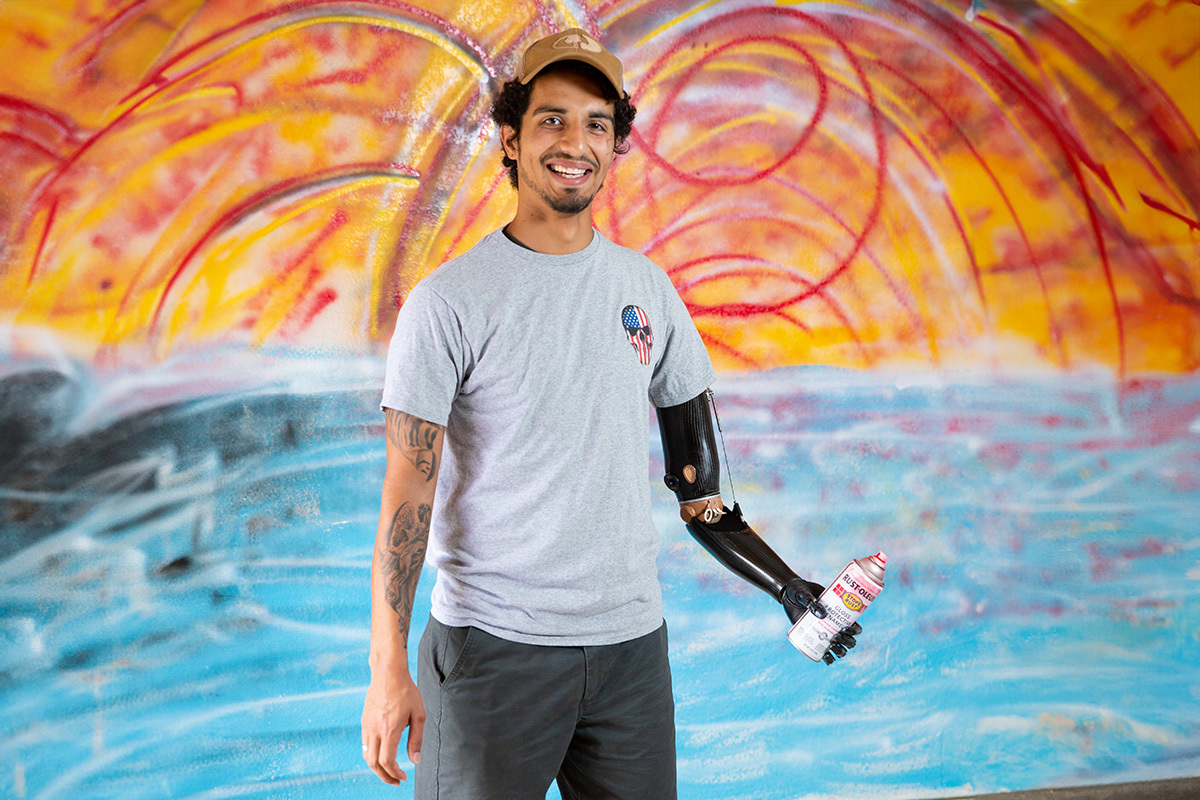Abram Baker has been a welder for over 30 years — he works in industrial maintenance. He’s used to 10-12-hour days in the shop. On weekends he likes to go off-roading in Jeeps with his family and friends. He owns an online shop called Blue Collar Brand, which you can learn more about on his Instagram page. You can also learn more about Abram on his patient profile page.
On October 14, 2019, Abram had an accident at work and lost his left hand and part of his forearm. The next month, he was on a plane headed from his home in Tennessee to Dallas, Texas, where our Arm Dynamics Southwest center is located. That following May, Abram was back in our center to make some adjustments to the two prosthetic devices he already had and to receive a new device.
Why does Abram need three devices? Read on.
A body-powered device for work:
Abram asked for us to customize his body-powered device by drilling holes in the carbon fiber socket. “The heat is always a factor, especially in the summertime. You generate quite a bit of heat in these things, in these devices. So, if you can have any type of help, it makes a difference.” Abram's accident has left his residual limb very sensitive to heat — the hotter his arm is, the more pain he feels. “Basically, I got a lot of bad nerves at the end of my arm, on the bottom too, and the hotter it is, the more aggravated it is.” The holes should keep Abram's arm cooler and allow him to wear his device for longer. “The holes will give me more time in the prosthesis without making my arm feel horrible.” The holes, combined with a moisture-wicking sock, have made quite a difference.
Abram also needed a prosthesis for everyday tasks and to give his arm a rest from the body-powered harness:
When Rob, our prosthetist in Dallas, originally fit Abe’s myoelectric prosthesis, Abram chose the TASKA hand. But he only had two sites for his myoelectric sensors. On this visit, Abram's myo was upgraded with the Coapt system, giving him 17 sensor sites to help give more precise control with his TASKA hand. “This new Coapt has made a big difference. The old system, you had to double clinch to get the 360-degree motion and that was bad, for me. With this new one, you just move your arm muscles naturally to move the wrist. It’s amazing, the difference.”
In addition, Abram asked Rob if there was any way they could make his arm a little cooler and asked Rob to install a small cooling fan inside the frame (only a couple of inches in diameter). Rob added little slits, or as he calls them, “shark gills”, to allow for air to flow into and away from the fan. The fan itself only adds a couple of ounces to the weight of the prosthesis, it’s so quiet it can’t be heard unless you put your ear right up to the device. Abram hadn't had much of a chance to test out the fan yet, but we hope it's working for him.
His most recent acquisition was his passive silicone restoration:
After over a year of living with his two other prosthetic arms, how did he come to decide he needed a passive arm? “When you go through the airport with your TASKA hand, everyone wants to talk to you. And once you tell your story so many times, you’re just, eh — you don’t want to all the time. I just want to be able to blend in with a crowd.” That’s an understandable request and something many of our patients have experienced.
“When people get in your personal space, that crosses a line. My wife and I went out to dinner for our anniversary and this woman there was so excited about my arm and the technology, and wanted to ask about my accident, that she actually sat down in the booth with us. And we were nice, but it was like, we just wanted to have a nice meal, and we didn’t get to have a dinner together. She ended up watching us eat.” We’re glad that prosthetic devices are so spellbinding for others, but we can fully understand needing that anonymity. Abe continued, “At the beginning of this journey, I did not want a passive device. I was against it. But here we are.”
We fit all our patients with custom-made devices, but some of them ask for more creative devices than others — like with Abe’s tattooed passive device above. We love the challenges our patients present to us, or the ideas they come up with and ask us to implement. What can we do for you or your patient? Is your story similar to Abram's? Please feel free to contact us or comment below.




![Tattoo Passive Arm600x900[2] copy](https://www.armdynamics.com/hs-fs/hubfs/Upper%20Limb%20Library/Tattoo%20Passive%20Arm600x900%5B2%5D%20copy.jpg?width=882&height=366&name=Tattoo%20Passive%20Arm600x900%5B2%5D%20copy.jpg)



%20President%20and%20Senior%20Clinical%20Director.jpg?width=600&height=600&name=John%20M.%20Miguelez%2c%20CP%2c%20FAAOP(D)%20President%20and%20Senior%20Clinical%20Director.jpg)










No Comments Yet
Let us know what you think